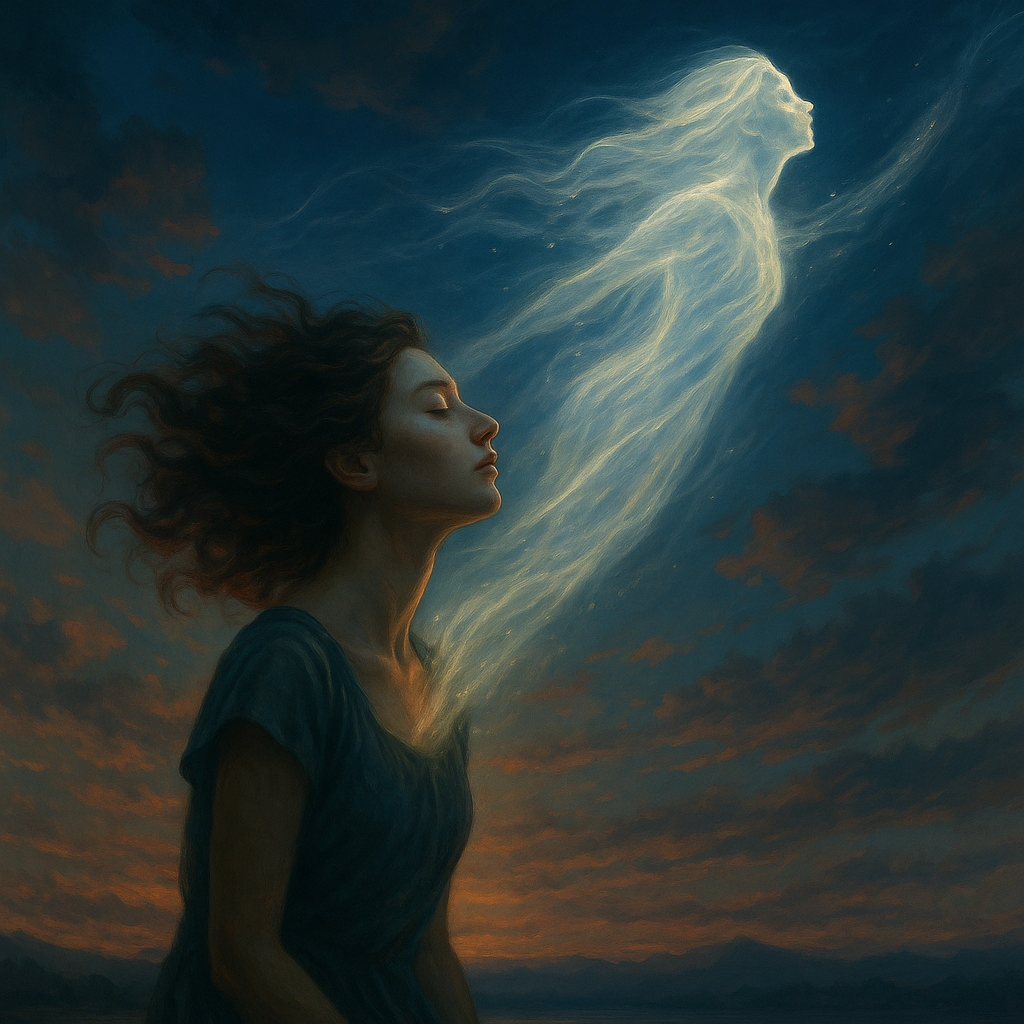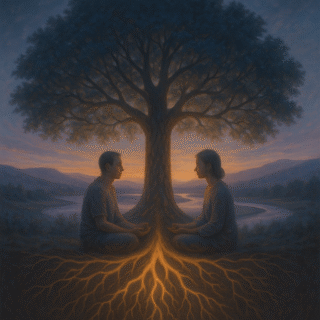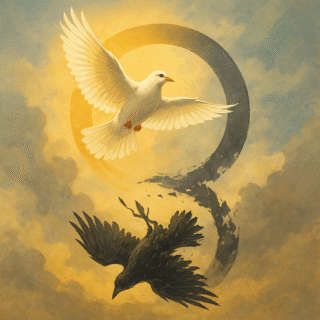THE SOUL IN INTEGRAL NONDUALISM
Being soulfully gay means living at the crossroads between emotional depth and ecstatic spirit, self-acceptance and self-transformation, connection to nature and contemplation of timeless realities. But what is it within us that is constant through all of these things? Is it a “soul”?
For some, the word soul sounds dated or theological, too burdened by dogma or sentimentality. For others, it’s a lifeline—a way of pointing to something real and enduring within us, something we intuit even if we cannot prove it. In the Unitive Way, the soul is neither a metaphysical ghost nor merely a poetic metaphor. It is the living pattern of our becoming, a shimmering thread that carries memory, meaning, longing, and presence. It is who we are, not just what we are. And to care for the soul is to honor that unfolding.

The Debate: Is the Soul or Self Real?
In nondual traditions, there has long been a debate about whether the self or soul truly exists. Classical Advaita Vedanta and many forms of Buddhist nonduality maintain that there is no enduring self—only the illusion of separateness arising from ignorance. These traditions emphasize that beneath all identities and stories lies pure awareness, which is unchanging, unborn, and impersonal.
But Integral Nondualism—what I call The Unitive Way—takes a different, more nuanced stance.
It acknowledges that while the ultimate truth may be formless, empty of self, the relative truth of our lives involves a self that is real enough: a psychological, emotional, and spiritual structure that develops over time. This self isn’t merely an illusion—it’s an evolving vessel for meaning, intimacy, and transformation. It has depth, history, aspirations. And it exists in relationship—to others, to culture, to Spirit.
In this frame, the soul and self are connected—not identical, but intimately related. The soul is not just your inner ego or narrative identity; it’s more like a transpersonal pull, a pattern that is both uniquely you and mysteriously more-than-you. It draws upon the individual unconscious, with your dreams and longings, and the collective unconscious, with its archetypes, myths, and spiritual archeologies. It drags us—sometimes kicking and screaming—into fuller truths. It doesn’t just reflect who we are now; it calls us toward who we are meant to become.
The Unitive Way Is Post-Metaphysical
Importantly, the Unitive Way doesn’t proffer a metaphysical theory of the soul. It doesn’t insist that the soul is a substance, or a ghost in the machine, or a divine fragment in exile. Perhaps the soul is a substance, or perhaps not—that’s not what concerns us. Instead, it proposes that soul is a story we tell—not just to describe ourselves, but to evoke what is truest, deepest, and most radiant in us.
In this sense, the Unitive Way is post-metaphysical: it does not claim to describe the ultimate furniture of the universe. It offers a framework for meaning-making—a living map of consciousness that honors the power of narrative, reflection, and intersubjective depth. We tell our stories to each other, and in the listening and the speaking, something sacred happens. Something whole. Our stories change us. They soften us. They reveal the soul in motion.
Rather than debating what the soul is, the Unitive Way asks:
What is your soul becoming, in and through your life story?
The Gay Soul Has a Shape
If every person has a soul, then what makes a gay soul different? Not in essence, perhaps, but in expression. The gay soul, especially when it is unashamed and fully incarnate, knows something of paradox: it lives in the body yet often outside the mainstream, feels love that has historically been taboo, and reaches toward transcendence even as it is politicized. This soul is marked by sensitivity, erotic intelligence, and a unique kind of wound-turned-gift.
Gay men in particular may carry wounds of shame, rejection, or invisibility. But those very wounds—if honored and not bypassed—can become openings into a deeper intimacy with the soul’s truth. The soul doesn’t want to be fixed or purified. It wants to be witnessed, touched, spoken to, danced with.

Four Archetypes: My Journey into Wholeness
Years ago, I encountered the work of Robert Moore, who described four fundamental archetypes of the mature masculine: Warrior, Lover, Magician, and King. These archetypes aren’t static roles—they are energies, currents of the psyche that guide and shape our inner life. Each one has taught me how to care for my soul, especially as a gay man who has faced his share of darkness and light.
As Robert Bly once wrote in Iron John:
“Where a man’s wound is, that is where his genius will be.”
That line haunted me—and guided me. My wounds, it turns out, were also gateways.
- The Warrior taught me to face the past without flinching. I had to summon courage—not the reckless kind, but the grounded, clear-eyed courage to face my mental illness: the depression, the panic attacks, the long nights of psychic fragmentation. To walk through those shadows without collapsing into self-hatred—that was a Warrior’s path.
- The Lover brought me back to life. For many years, I lived in a kind of emotional numbness. Past rejections—especially those that came after I disclosed my HIV status to lovers—left deep scars. I built walls without realizing it. The Lover taught me to feel again, to risk openness, to love not despite my pain but through it. He taught me that eros is a teacher, not a threat.
- The Magician was always whispering in the background. He showed me how to take fragments of philosophy, theology, sexuality, and real-world experience, and alchemize them into a coherent whole. He gave me the tools to name my inner worlds, to write, to teach, to synthesize. The Magician loves meaning—and he helped me find mine.
- And finally, The King gave me structure. He didn’t arrive with a crown and fanfare; he arrived slowly, asking me to integrate the other energies with grace. The King tempers the Warrior, deepens the Lover, focuses the Magician. He asks: What is your kingdom? What are you building with your life? What legacy will you leave?
Together, these archetypes helped me see that my soul wasn’t broken—it was unfinished. And its wholeness didn’t lie in transcending my gayness, my wounds, or my struggles, but in weaving them together into a pattern uniquely my own.
Caring for the Gay Soul
So what does it mean to care for the gay soul today?
- Make time for solitude and silence. The soul whispers in quietude.
- Surround yourself with beauty. Art, music, nature, firefighter calendars—whatever awakens awe.
- Always be reading at least one book. TV and movies are fine, but they don’t inspire the imagination in the same way as a book. Enliven your imagination.
- Honor your eros. Not just through sex, but through sacred touch, flirtation with life, and inner radiance.
- Write, dream, and reflect. Journaling, active imagination, dreamwork—they open the doors to soul-language.
- Grieve your wounds. Not to get over them, but to give them voice and sacred place.
- Gather in queer ritual. Ceremony, storytelling, or simply sharing space with others who honor Spirit in flesh. Going out to Sunday brunch with your friends counts. Playing rugby with your buddies counts, too.
- Get a cat. Cats are awesome, and they will connect with you on a soul level.
- Name your archetypes. Are you being called to act with strength, to feel with compassion, to create with insight, to lead with wisdom? Befriend your archetypes. Make love to them.
Becoming Who You Already Are
In the Unitive Way, the soul is not something you own, lose, or save. It is the unique vibration of Spirit as you. It is already whole, already radiant—but often obscured by fear, shame, or speed. The journey isn’t to become someone else. It’s to become more truly who you already are, at the deepest level.
As Thomas Moore reminds us:
“Care of the soul is not primarily a method of problem solving. Rather, it is a way of tending the soul, of listening to its needs, and honoring its expressions.”
So yes, there is such a thing as the gay soul. And it doesn’t need fixing. It needs tending—with patience, with reverence, and with the wild and tender love of one who knows that even the broken parts belong.
Because the soul—your soul—is always telling a story. And if we listen well enough, it might just be telling us how to come home.




